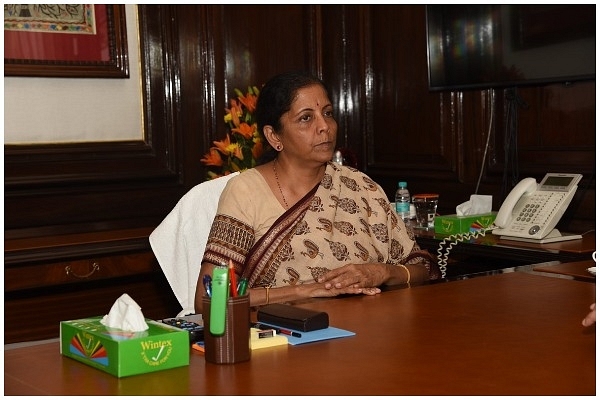Economy
Memo To Nirmala Sitharaman: Honest Admission Of Fiscal Slippage Better Than Attempting To Window-Dress Deficit
- Sitharaman has to bite the bullet. She should seek to start with a realistic fiscal deficit target in the range of 3.8-4 per cent.

Finance Minister Nirmala Sitharaman (@FinMinIndia/Twitter.com)
One of the laudable achievements of Narendra Modi’s first term was a credible fiscal record, with little attempt at legerdemain or hanky-panky. Unlike the P Chidambaram years, where fiscal roadmaps were achieved by hiding revenue and expenditure slippages through the issue of bonds, shifting of current year expenses to the next year, and extracting higher dividends from public sector units at will, in the first four years of the Modi regime (2014-18), fiscal compliance was largely believable – and qualitatively better.
Not any more. In the last fiscal year, 2018-19, the revenue slippage has been so large and humongous that Arun Jaitley had resorted to the usual tricks to hide the deficit. To put it simply, the achievement of the fiscal deficit target of 3.4 per cent in the revised estimates (presented in the interim budget) is a piece of pure fiction. This implies that the targeted maintenance of 3.4 per cent in 2019-20 will also be impossible to achieve, unless the same kind of fiscal skullduggery is used to hide the real state of affairs.
In 2018-19, the Union government’s net tax receipts were short of budget estimates by a massive Rs 1.67 lakh crore, and the cuts enforced to reduce the deficit to then promised 3.4 per cent were not of the same magnitude. The huge gap was made up partly through a Rs 13,000 crore cut in capital spending, and a Rs 11,000 crore increase in capital and non-tax receipts. Minus this Rs 24,000 crore, and you still get a huge deficit of Rs 1.43 lakh crore.
Add Rs 1.43 lakh crore to the revised deficit figure of Rs 6.34 lakh crore, on a GDP base of Rs 188.40 lakh crore and you get an actual fiscal deficit of nearly 4.1 percent. While the actual figure may be a bit lower if the nominal GDP figure is raised a bit, what we are left with is one stark reality: the Modi government inherited a fictitious budget deficit figure of 4.1 per cent (the actual was closer to 4.7 per cent, since many expenses relating to 2013-14 were shifted to 2014-15), and it is ending its first term more or less at that same level.
The final figure of 3.4 per cent excludes off-budget expenses shifted to public sector entities like Food Corporation of India, National Housing Bank, Nabard, etc. These entities borrowed money to make up for the outlays they were promised by the government in its previous budget. These sums have to be paid, and when they are, the budget deficit in the subsequent year will bloat, unless you continue the dubious strategy of shifting expenses to the following years endlessly. At some point, the chickens will come home to roost.
If we assume that the actual deficit of 2018-19 is closer to a range of 3.8-4 per cent, it follows that the next budget to be presented on 5 July by new Finance Minister Nirmala Sitharaman faces two choices: one is to drastically scale down expenditures, including on much-needed infrastructure, or accept a much higher level of fiscal deficit than what was indicated in the interim budget (ie, 3.4 per cent).
If we accept another reality, that the economy is slowing and that corporate investment is not going to revive too soon, it would make no sense to impose another massive fiscal squeeze since window-dressing the deficit is not going to help.
Sitharaman has to bite the bullet. She should seek to revive the economy by bringing all the off-balance-sheet loans back into the budget and start with a realistic fiscal deficit target in the range of 3.8-4 per cent. She can restate the 2018-19 accounts and show a marginal fiscal reduction this year, and promise to resume the glide path from next year, once the economy revives.
What she should not do is to present a fictitious fiscal deficit target of 3.4 percent which she cannot guarantee in a year of slowdown and when banks and the non-bank financial sector need lots of capital to resume lending.
Since the Monetary Policy Committee (MPC) is no help – it believes in homoeopathic doses of rate cuts which anyway will not be passed on in full by banks till they are comfortably recapitalised – Sitharaman should let the fiscal slippage work to her advantage by reflating the economy. Inflation risk is worth taking a gamble on.
An honest admission of fiscal slippage is better than a dishonest attempt to claim fiscal compliance. And yes, in future, she should attempt to shift the budget exercise to accrual-based accounting, where both revenues and expenditures are shown when they accrue, and not on a cash basis.
Support Swarajya's 50 Ground Reports Project & Sponsor A Story
Every general election Swarajya does a 50 ground reports project.
Aimed only at serious readers and those who appreciate the nuances of political undercurrents, the project provides a sense of India's electoral landscape. As you know, these reports are produced after considerable investment of travel, time and effort on the ground.
This time too we've kicked off the project in style and have covered over 30 constituencies already. If you're someone who appreciates such work and have enjoyed our coverage please consider sponsoring a ground report for just Rs 2999 to Rs 19,999 - it goes a long way in helping us produce more quality reportage.
You can also back this project by becoming a subscriber for as little as Rs 999 - so do click on this links and choose a plan that suits you and back us.
Click below to contribute.
Latest